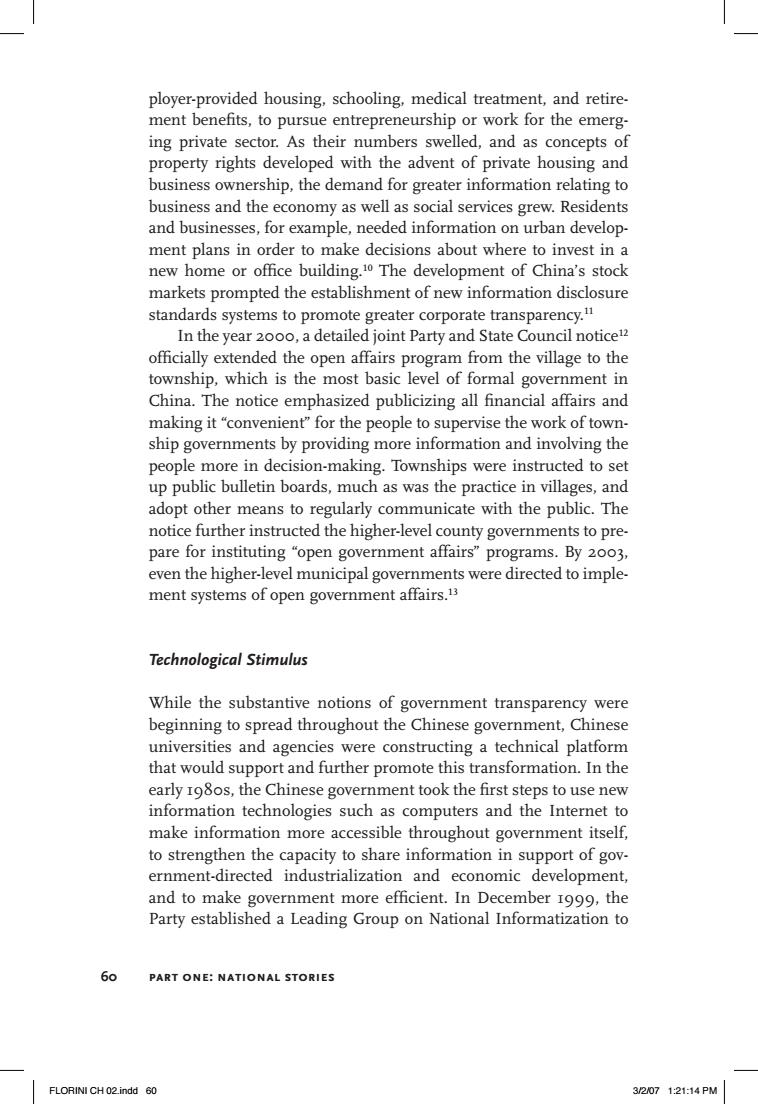正在加载图片...

ployer-provided housing,schooling,medical treatment,and retire. ment benefits,to pursue entrepreneurship or work for the emerg- ing private sector.As their numbers swelled,and as concepts of property rights developed with the advent of private housing and business ownership,the demand for greater information relating to business and the economy as well as social services grew.Residents and businesses,for example,needed information on urban develop- ment plans in order to make decisions about where to invest in a new home or office building.10 The development of China's stock markets prompted the establishment of new information disclosure standards systems to promote greater corporate transparency. In the year 2o00,a detailed joint Party and State Council notice12 officially extended the open affairs program from the village to the township,which is the most basic level of formal government in China.The notice emphasized publicizing all financial affairs and making it "convenient"for the people to supervise the work of town- ship governments by providing more information and involving the people more in decision-making.Townships were instructed to set up public bulletin boards,much as was the practice in villages,and adopt other means to regularly communicate with the public.The notice further instructed the higher-level county governments to pre- pare for instituting"open government affairs"programs.By 2003, even the higher-level municipal governments were directed to imple- ment systems of open government affairs.13 Technological Stimulus While the substantive notions of government transparency were beginning to spread throughout the Chinese government,Chinese universities and agencies were constructing a technical platform that would support and further promote this transformation.In the early Io8os,the Chinese government took the first steps to use new information technologies such as computers and the Internet to make information more accessible throughout government itself, to strengthen the capacity to share information in support of gov- ernment-directed industrialization and economic development, and to make government more efficient.In December 1999,the Party established a Leading Group on National Informatization to 60 PART ONE:NATIONAL STORIES FLORINI CH02.indd 60 3/2071:21:14PM60 part one: national stories ployer-provided housing, schooling, medical treatment, and retirement benefits, to pursue entrepreneurship or work for the emerging private sector. As their numbers swelled, and as concepts of property rights developed with the advent of private housing and business ownership, the demand for greater information relating to business and the economy as well as social services grew. Residents and businesses, for example, needed information on urban development plans in order to make decisions about where to invest in a new home or office building.10 The development of China’s stock markets prompted the establishment of new information disclosure standards systems to promote greater corporate transparency.11 In the year 2000, a detailed joint Party and State Council notice12 officially extended the open affairs program from the village to the township, which is the most basic level of formal government in China. The notice emphasized publicizing all financial affairs and making it “convenient” for the people to supervise the work of township governments by providing more information and involving the people more in decision-making. Townships were instructed to set up public bulletin boards, much as was the practice in villages, and adopt other means to regularly communicate with the public. The notice further instructed the higher-level county governments to prepare for instituting “open government affairs” programs. By 2003, even the higher-level municipal governments were directed to implement systems of open government affairs.13 Technological Stimulus While the substantive notions of government transparency were beginning to spread throughout the Chinese government, Chinese universities and agencies were constructing a technical platform that would support and further promote this transformation. In the early 1980s, the Chinese government took the first steps to use new information technologies such as computers and the Internet to make information more accessible throughout government itself, to strengthen the capacity to share information in support of government-directed industrialization and economic development, and to make government more efficient. In December 1999, the Party established a Leading Group on National Informatization to FLORINI CH 02.indd 60 3/2/07 1:21:14 PM